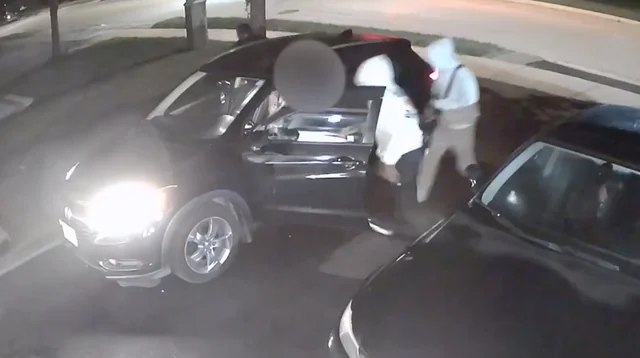કેનેડામાં કાર ચોરીમાં ચિંતાજનક વધારો થઈ રહ્યો છે, 2022 માં 105,000 થી વધુ વાહનો ચોરાઈ ગયા – સરેરાશ દર પાંચ મિનિટે એક કાર. આ વધારાથી સામાન્ય નાગરિકો અને ઉચ્ચ-પ્રોફાઇલ વ્યક્તિઓને અસર થઈ છે, જેમાં ફેડરલ ન્યાય પ્રધાનનો પણ સમાવેશ થાય છે, જેમની સરકાર દ્વારા જારી કરાયેલ ટોયોટા હાઇલેન્ડર XLE બે વાર ચોરાઈ ગઈ હતી.
પરિસ્થિતિ એટલી હદે વધી ગઈ છે કે કેનેડાના વીમા બ્યુરોએ તેને “રાષ્ટ્રીય કટોકટી” જાહેર કરી છે, જેમાં વીમા કંપનીઓએ ગયા વર્ષે જ વાહન ચોરીના દાવાઓમાં C$1.5 બિલિયનથી વધુ રકમ ચૂકવી દીધી છે. ઇન્ટરપોલ અનુસાર, અધિકારીઓ આ રોગચાળાનો સામનો કરી રહ્યા છે, જેણે કેનેડાને કાર ચોરી માટે ટોચના 10 સૌથી ખરાબ દેશોમાં સ્થાન આપ્યું છે. ફેબ્રુઆરીમાં ઇન્ટરપોલ સાથે તેમના ડેટાને એકીકૃત કર્યા પછી, કેનેડિયન અધિકારીઓએ વિશ્વભરમાં 1,500 થી વધુ ચોરાયેલા વાહનો શોધી કાઢ્યા છે, જેમાં દર અઠવાડિયે આશરે 200 વધુ ઓળખાય છે, સામાન્ય રીતે આંતરરાષ્ટ્રીય બંદરો પર.

એકવાર ચોરાઈ ગયા પછી, આ વાહનો ઘણીવાર અન્ય ગુનાઓ માટે સાધન તરીકે કામ કરે છે, સ્થાનિક સ્તરે શંકાસ્પદ ખરીદદારોને વેચવામાં આવે છે, અથવા ફરીથી વેચવા માટે વિદેશમાં મોકલવામાં આવે છે. વૈશ્વિક બજારમાં ચોક્કસ કાર મોડેલોનું આકર્ષણ સંગઠિત ગુના જૂથો માટે ઓટો ચોરીને એક આકર્ષક સાહસ બનાવે છે, ખાસ કરીને રોગચાળાને કારણે કારની અછતને ધ્યાનમાં રાખીને, નવા અને વપરાયેલા વાહનોની માંગમાં વધારો થયો છે.
સમગ્ર કેનેડામાં પોલીસે વાહન ચોરી અટકાવવા અંગે જાહેર બુલેટિન જારી કર્યા છે. દરમિયાન, રહેવાસીઓએ કાર ટ્રેકર સ્થાપિત કરવા, ખાનગી સુરક્ષા ભાડે રાખવા અને તેમના ડ્રાઇવ વેમાં રિટ્રેક્ટેબલ બોલાર્ડ્સ ગોઠવવા જેવા પગલાંનો ઉપયોગ કરીને મામલો પોતાના હાથમાં લીધો છે.
આ પ્રયાસો છતાં, ચોરીઓ સતત ચાલુ રહે છે. કેનેડિયન બંદરો પરની કામગીરી, જે બહાર જતા શિપમેન્ટ કરતાં આવતા શિપમેન્ટ પર વધુ ધ્યાન કેન્દ્રિત કરે છે, તે મુદ્દાને વધુ ખરાબ કરે છે. એકવાર ચોરાયેલી કાર શિપિંગ કન્ટેનરમાં પેક કરવામાં આવે છે, પછી તેને શોધવાનું મુશ્કેલ બની જાય છે. કેનેડા બોર્ડર સર્વિસીસ એજન્સી (CBSA) ને સ્ટાફની અછત અને જૂની ટેકનોલોજી માટે ટીકાનો સામનો કરવો પડ્યો છે, જે પર્યાપ્ત નિરીક્ષણમાં અવરોધ ઉભો કરે છે.
સમસ્યાને સમજવા અને તેનો સામનો કરવાના એક નોંધપાત્ર પ્રયાસમાં, બ્રેમ્પટનના મેયર પેટ્રિક બ્રાઉને યુએસ નિરીક્ષણ યુક્તિઓમાંથી શીખવા માટે ન્યુ જર્સીના પોર્ટ નેવાર્ક કન્ટેનર ટર્મિનલની મુલાકાત લીધી. તેમણે અવલોકન કર્યું કે અમેરિકન સત્તાવાળાઓ અદ્યતન સ્કેનર્સ અને ઘનતા માપનનો ઉપયોગ કરે છે, જે તકનીકોનો કેનેડામાં હાલમાં અભાવ છે.

કેનેડિયન સરકારે CBSA ની ક્ષમતાઓને મજબૂત બનાવવા અને ઓટો ચોરી સામે લડવા માટે પોલીસના પ્રયાસોને ટેકો આપવા માટે નોંધપાત્ર રોકાણોની જાહેરાત કરી છે. જોકે, નિષ્ણાતો દલીલ કરે છે કે કાર ઉત્પાદકોએ વાહનો ચોરી કરવા માટે વધુ સક્રિય રહેવું જોઈએ. સુરક્ષાના પગલાં વધારવા છતાં, દૃઢ ચોરો તેમને ટાળવાના રસ્તાઓ શોધવાનું ચાલુ રાખે છે, જેના કારણે કાર માલિકો હતાશ અને નિરાશ થઈ જાય છે.
પિયર પોઇલીવરે પરિસ્થિતિની ગંભીરતા પર પ્રકાશ પાડ્યો હતો અને નોંધ્યું હતું કે કેનેડામાં કાર ચોરીનો દર આશ્ચર્યજનક રીતે ઊંચો છે, કારણ કે અમેરિકા અને યુકેની તુલનામાં દેશની વસ્તી પ્રમાણમાં ઓછી છે. “કેનેડામાં પણ અમેરિકા જેટલા બંદર શહેરો નથી,” તેમણે કહ્યું. જ્યારે કેનેડામાં પ્રતિ 100,000 લોકો દીઠ કાર ચોરીનો દર અમેરિકા જેટલો જ છે, તે ઇંગ્લેન્ડ અને વેલ્સના દર કરતાં વધુ છે, જે દેશની પરિસ્થિતિને ખાસ કરીને ભયાનક બનાવે છે.

પિયર પોઇલીવરે પણ આ મુદ્દા પર ચેતવણી ઉચ્ચારી છે, ખાસ કરીને બ્રેમ્પટન, ઓન્ટારિયોમાં કાર ચોરીના સંકટને પ્રકાશિત કર્યું છે. તેમણે વધતી જતી સમસ્યાને ઉકેલવા માટે તાત્કાલિક પગલાં લેવાની હાકલ કરી છે, સરકારને વધુ મજબૂત સુરક્ષા પગલાં અમલમાં મૂકવા અને કાયદા અમલીકરણ એજન્સીઓને ટેકો આપવા વિનંતી કરી છે.
કાર ચોરી એક સતત સમસ્યા બની રહી હોવાથી, કેનેડિયનોને એવા વાતાવરણમાં નેવિગેટ કરવાનું બાકી છે જ્યાં પોતાના વાહનને સુરક્ષિત રાખવું વધુને વધુ પડકારજનક અને ઘણીવાર નિરાશાજનક બની ગયું છે.